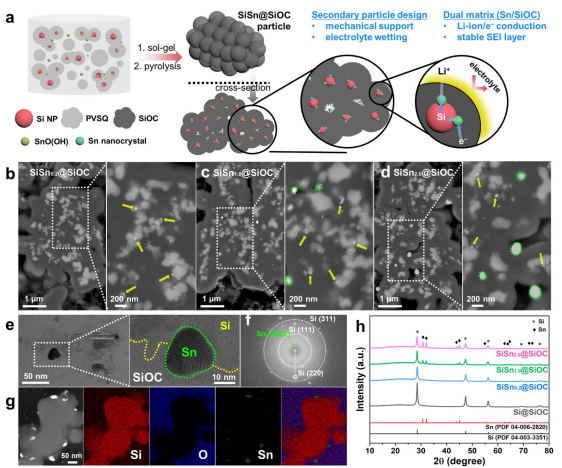Covalent-assisted seeding of Si nanoparticles into a dual-matrix design toward advanced Si-based Li-ion batteries
- Year
- 2024
- Author
- Kwanghyun Do, Changyong Park, Jeonguk Hwang, Sucheol Kim, Yeju Jung, Se Hun Lee, Hee-Dae Lim*, Heejoon Ahn*
- Journal
- Journal of Materials Chemistry A
- Vol
- 12
- Page
- 11062

Silicon oxycarbide (SiOC) holds enormous promise as a buffer matrix material in Si-based composites owing to its outstanding electro-chemo-mechanical stability and cost-effectiveness. However, there is an urgent need to develop a new approach for establishing robust chemical bonds or interactions between Si nanoparticles (NPs) and SiOC. This study introduces a novel silicon alkoxide-based sol–gel method for synthesizing Si-NP-seeded SiOC (Si@SiOC), resulting in the covalent-assisted seeding (CAS) of Si NPs into the matrix. As a result, the Si@SiOC composites exhibited improved reversible capacity and coulombic efficiency compared to bare SiOC. Nevertheless, an inherent trade-off exists between capacity and cycling stability with increasing Si NP content. To address this challenge, a dual-matrix design is proposed by integrating Sn nanocrystals into a Si@SiOC matrix. The introduction of Sn as a pore trigger led to the creation of internal artificial voids and simultaneously enhanced both the ionic and electronic conductivities. Consequently, the SiSn@SiOC composites demonstrated superior reversible capacities, initial coulombic efficiencies, and cycling stabilities compared to Si@SiOC. This study not only introduces an innovative method for establishing robust bonds between Si NPs and the SiOC host but also represents a novel approach by employing Sn as a pore-inducing agent to further enhance electrochemical performance.